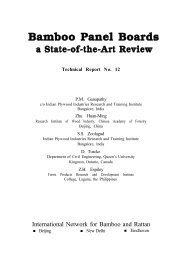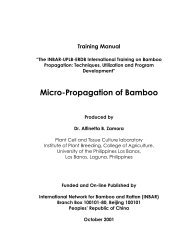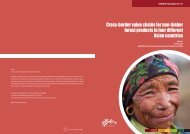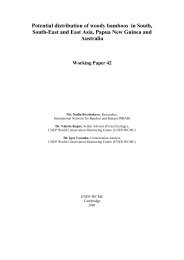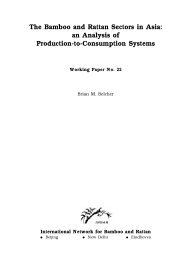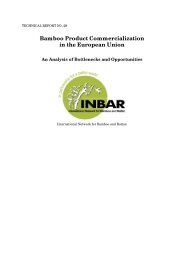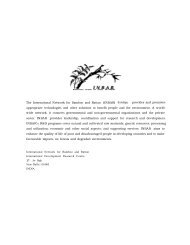ISSN ………… - International Network for Bamboo and Rattan
ISSN ………… - International Network for Bamboo and Rattan
ISSN ………… - International Network for Bamboo and Rattan
You also want an ePaper? Increase the reach of your titles
YUMPU automatically turns print PDFs into web optimized ePapers that Google loves.
6. CHEMICAL COMPOSITION<br />
In<strong>for</strong>mation on the chemical composition of bamboo is important as far as its utilization <strong>for</strong> pulping<br />
is concerned. Holocellulose (also called hemicelluloses) is the main component contributing to the<br />
strength of paper made from bamboo. The high cellulose content <strong>and</strong> a yield of 40-50 per cent pulp<br />
make bamboo an ideal raw material <strong>for</strong> manufacture of paper. From the angle of paper production, the<br />
average chemical composition of bamboo (on OD weight basis) is :<br />
Holocellulose 61 - 71%<br />
Lignin 20 - 30%<br />
Pentosans 16 - 21%<br />
Silica 0.5-4.0%<br />
Ash 1.0-9.0%<br />
The solubility in different solvents are :<br />
Cold water 1.6- 4.6%<br />
Hot water 3.1- 7.0%<br />
Alcohol-benzene 0.3- 7.8%<br />
1% NaOH 15 - 39%<br />
Apart from the high cellulose content, the other factors like high lignin, pentosans <strong>and</strong> silica contents<br />
as well as higher solubilities are not in favour of ideal pulping conditions. But, since it contains higher<br />
cellulose content, bamboo is a preferred raw material <strong>for</strong> pulping.<br />
Bhargava (1945) 136 provided data on the proximate chemical analysis of 10 bamboo species. In<br />
Dendrocalamus strictus, it was found that the proximate chemical composition varied with locality<br />
<strong>and</strong> also due to flowering.<br />
<strong>Bamboo</strong> pulps from Ochl<strong>and</strong>ra abyssinica <strong>and</strong> Oxytenanthera abyssinica have high alpha-cellulose<br />
content (Monteiro 1949 306 ; Seabra 1954) 189 . Numerous reports are available on the chemical<br />
composition of different species of bamboos grown in different countries [<strong>for</strong> example, Istas <strong>and</strong><br />
Hontoy (1952) 219 <strong>and</strong> Istas et al. (1956) 159 on the Belgian Congo species Sasa japonica, S. kurilensis,<br />
Bambusa hoffii, B. vulgaris, Gigantochloa aspera <strong>and</strong> Ochl<strong>and</strong>ra travancorica; Monsalud <strong>and</strong><br />
Tamolang (1962) 8 on some Philippine species; Tono (1963) 261 on some Japanese bamboos; Nair<br />
(1970) 9 , Maheshwari et al. (1976) 171, 227 , Azzini (1976) 366 , Bhola (1976) 218 , K<strong>and</strong>elaki (1977) 103 ,<br />
Guha et al. (1980) 452 , Karim et al. (1994) 407 on the Indian species Dendrocalamus strictus,<br />
Bambusa bambos, Oxytenanthera monostigma, Bambusa vulgaris, Bambusa tulda, Phyllostachys spp.<br />
<strong>and</strong> Melocanna baccifera; Ku (1971) 165 on Taiwan bamboos including Bambusa beecheyana Munro.<br />
39



